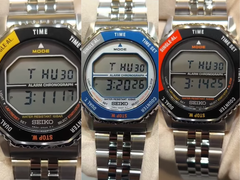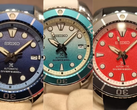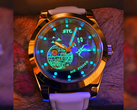@SeikoLeaks posted hands-on clips of the newly released Seiko Rotocall reissues on YouTube earlier this month (Nov 1), and they give us a much clearer look at all three variants - SMGG17P1, SMGG19P1, and SMGG21P1 - now that they are officially available for purchase (although they are currently out of stock). The videos reveal a few real-world traits that are not exactly obvious in Seiko’s press renders.
The first thing that stands out is the bezel finish. Seiko’s official images showed the colors cleanly separated, but the hands-on footage confirms that the bezel inserts have a slightly satin texture rather than a glossy one. The SMGG17P1 (yellow-black) looks the most faithful to the original Rotocall style, while the SMGG19P1 (red-black) has way deeper tones than in the marketing photos - the red section appears more muted in real light, closer to burnt orange than bright red. Meanwhile, the SMGG21P1 (blue-silver) variant has the crispest contrast, and the blue ring shows a mild metallic flare when the watch is tilted.
The videos also confirm that the bracelet isn’t a simple folded-link design. It appears to be a multi-link style with alternating polished and brushed surfaces, which gives it more complexity than expected for a digital model in this price range. The clasp looks standard Seiko, but the bracelet articulation seems better than many older Rotocall bracelets.
On the display side, the digit alignment and contrast look slightly sharper than the previous press images suggested. Seiko did mention an updated quartz movement in the launch spec, and the hands-on videos confirm that the screens have good contrast, especially under indoor lighting. The dual-display layout - the upper section for mode/time, lower for chronograph/countdown - also looks to be unchanged from the original, but the refreshed backlight and cleaner typography surely make the reissue feel more modern.
Another detail worth noting is that the rotating bezel clicks visibly and cleanly in the footage. This was a defining trait of the 1980s Rotocall, since the bezel acted as a physical mode selector. The new models seem to preserve that exact interaction, which should be great for those who prefer tactile controls over multi-button navigation. For a niche digital release with NASA history behind it, the real-world clips affirm that Seiko has kept the charm intact rather than modernizing it for the sake of it.





















